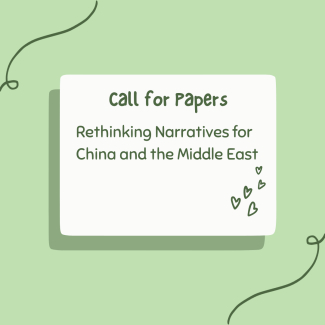
The Center for East Asian Studies is cosponsoring an upcoming conference with the Middle East Center at University of Pennsylvania. The conference, to be held in Spring 2021, will be on the theme: Rethinking Narratives of China and the Middle East: The Silk Roads and Beyond
The aim of the conference is to foster a creative dialogue — which we believe is long overdue — between scholars of modern and contemporary China/Middle East relations and those working on earlier periods, with the goal of questioning and complicating the conventional narratives frequently heard around these issues.
Please circulate as widely as possible to those you think might be interested. And kindly note that abstracts are due on 21 January 2020
Rethinking Narratives of China and the Middle East
The Silk Roads and Beyond
University of Pennsylvania, Philadelphia
April 8th-10th, 2021
Keynote Address: Peter Frankopan
Program Committee: William Figueroa, Mohammadbagher Forough, John Garver, John Ghazvinian, Dru Gladney, Renata Holod, Tugrul Keskin, Victor Mair, Dorraj Manochehr, Eleanor Sims, Jinping Wang, Bingbing Wu
Details below:
The last decade has seen a great deal of scholarly attention on the relationship between China and the Middle East. The majority of these works have been focused on the role of the modern Chinese state in the region. Countless studies and reports have been authored exploring Chinese investment in Middle Eastern economies, its impact on the politics of oil, and the growing interest that Beijing has taken in the region as a whole. Seen through the prism of U.S. foreign policy, China has been configured as a potential threat, possible ally, and above all a growing challenge to U.S. hegemony. New economic and trade initiatives and a flurry of Chinese goods and construction services throughout the region have had a significant impact on existing relationships and geopolitical calculations. The growing presence of Chinese workers and products have transformed the daily lives, consumption habits, and attitudes of many people who are witnessing these transformations first-hand. Whether these changes are disruptive and exploitative, or stabilizing and mutually beneficial is a hotly debated question, but there is no denying that China is becoming a major player in the Middle East.
Studies of the ancient, medieval, and pre-modern relationship between these two major cultural centers have also been flourishing. From maritime trade routes that stretched from the Chinese coast to the Red Sea, to the spread of Zoroastrianism, Christianity, and Islam in the Middle Kingdom, researchers have begun to recognize the historical roots of China’s seemingly novel interest in the Middle East. Mutual influences have been identified in the fields of art, literature, and architecture, especially after the Mongol invasions of the 13th century, which directly connected all of Asia for the first time in history. The world’s two largest collections of Chinese blue-and-white porcelain wares outside China proper are in Turkey and Iran, respectively, collected meticulously by Ottoman sultans and by Shah Abbas I, founder of the Safavid Dynasty in Iran. Although partly spurred by the rise of modern interest in Sino-Middle Eastern connections, this turn in the literature has provided new ways to explore the history of both regions without direct comparison to developments in the West.
“The Silk Road” has often provided a common framework for both fields, from the traditional overland and maritime Silk Roads of ancient times to the “One Belt, One Road” initiative promoted by China today. This framework tends to emphasize a long history of friendly and mutually beneficial interactions, interrupted by the intrusions of Western colonialism, and currently being restored to its former glory. The purpose of this conference is to foster a creative dialogue between scholars of modern Sino-Middle Eastern relations with those working on earlier periods, with the goal of questioning and complicating these conventional narratives. By treating modern Sino-Middle Eastern connections as historically rooted phenomena that expresses complex economic, political, and cultural interactions, it hopes to encourage scholars to move beyond the conventional and explore the many forms of interaction and exchange between China and the Middle East, both in ancient times and today.
The following is a non-exhaustive list of potential topics; however, we will consider any paper that explores connections between China and the Middle East.
Abstracts that examines the relationship between China and the Middle East, both ancient and modern are encouraged, and papers that incorporate additional regions, such as Europe, Central Asia, or South/Southeast Asia are also encouraged, provided they are also incorporate both China and a country in the Middle East, broadly construed.
Ancient and Modern…
Religious and Philosophical Exchange
Cultural and Artistic Exchange
Political and Ideological Exchange
Economic and Technological Exchange
Linguistic and Literary Exchange
Trade and Transportation Networks
Belt and Road Initiative (BRI)
Politics of Modern Sino-Middle Eastern Relations
Security and Political Stability
Geopolitics and Geoeconomics of China and the Middle East
Please send abstracts (350 word limit) and a 1-page CV to mec-conference@sas.upenn.edu by 11:59 PM EST Monday, January 21st, 2020